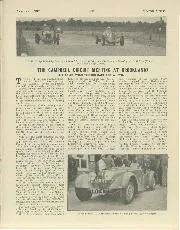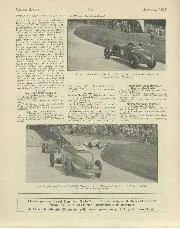

THE CAMPBELL CIRCUIT MEETING AT BROOKLANDS
THE CAMPBELL CIRCUIT MEETING AT BROOKLANDS H. HADLEY WINS THE BIG RACE FOR AUSTIN THE first of the long-awaited shorthandicap B.A.R.C. meetings over the Campbell circuit road-course was held at…
When I used to test a new car, there were certain criteria against which I judged it, and that’s probably not very surprising. These criteria changed order depending on the car, because I’d not be thinking too hard about luggage space in a Ferrari F50 nor handling characteristics in a Micra, but there they were and around them my world revolved. With most new cars today they’re not there any more or, to be strictly accurate, they remain but so thoroughly displaced by a new imperative as to have become obscured.
This moment of realisation came part way through a day I organise every year where the six British members of the Car of the Year jury gather together to test the seven cars that have been shortlisted for that year’s award. And as I sat in each, taking notes and making my acquaintance, I realised that what mattered most to me about a modern car was no longer how fast it went, nor how well it handled, but how little it annoyed me. Sad, isn’t it?
Some cars start patronising you the moment you open the door. They bing for no reason I can discern. Then if you try to do something as wicked as release the handbrake without your foot being on the brake, they start reproachfully bonging instead. Or simply won’t let you. Then, once underway, you can count on being scolded for being too close to the car in front and if it doesn’t like your line through any given corner, it will wrest control of the steering and describe the one it prefers instead.
Now, if you have the time, the inclination and the appropriate doctorate, you can dive through the layers of menus provided by that ever-so-luxurious touchscreen (which exist not for your convenience but to save money from homologating physical controls like buttons), and turn off all such ‘driver assistance’ aids. But if you stop for any reason and power down the car for even a second, by the time you’re moving again, they’ve all turned themselves back on again.
Why? Because the default setting of most newly introduced mass-market cars today is that customers are morons. Such morons indeed that they are quite incapable of driving by themselves without the car’s ‘assistance’ despite the existence in their wallet or purse of a plastic certificate stating to the contrary. They are this way partly because of current and impending legislation and partly because manufacturers are so terrified of being docked a star in their EuroNCAP crash test they’ll happily ruin a car to avoid it. But what of all the crashes that happen through people staring at indecipherable screens instead of the road? EuroNCAP doesn’t test for that.
A few days ago I found myself at the wheel of a Ford Fiesta. There was nothing remotely special about it. It was a 1-litre model, powered by a three-cylinder engine developing 94bhp. And it was outstanding, as good in its class as anything on sale. I mean it, and not just because its design is old enough to have a manual handbrake and it doesn’t try to help you drive. The engine is sweet and sparky, the six-speed manual gearbox short of throw and snappy in action. The steering is linear, accurate and perfectly weighted, the chassis agile yet poised. It’s quiet, comfortable and has an ‘infotainment’ system even I can understand.
If someone said, “That’s it, this is all you’ll ever drive again,” I’m not saying I’d relish the prospect, but I wouldn’t dread it either. So I’m glad the Fiesta is Britain’s perennially best-selling car even if, as I write, it’s been temporarily knocked off the top spot by the chip crisis. If this is the car more drivers find themselves in than any other, that makes me happy. Because when I first started doing this job, the best-seller was also a Ford, the fourth-generation Escort to be specific, and it was one of the worst cars I have ever driven.
What changed? The internet mainly. People got informed and started walking into dealerships knowing more about the car they wanted to buy than the person trying to sell it to them. Ultimately, the product won.
“Lawrence Stroll doesn’t like the name Vanquish, so it’s out”
The Aston Martin Vanquish is dead. Not the car you understand, just the name. The next in a two-decade-long line of Vanquish supercars was to have been the company’s forthcoming mid-engined machine, to rival the Ferrari 296 GTB and McLaren 720S. But executive chairman Lawrence Stroll told me he doesn’t like it; it’s out. What will it be called instead? He says he has 18 months to decide. Me? I’m glad. I never liked the name. It’s a word that seems more frequently used in the passive, “they were vanquished”, than active, “I went and did some vanquishing”, and never quite sat right in my head. But I concede it’s also because every time I hear it, I still recall former Aston boss Ulrich Bez introducing the original in 2001 and hearing the titters from the assembled every time he said the word in his German accent, which translated ‘v’s into ‘w’s. Pathetic I know.
What would I call it? I’d buy the rights to the V-bomber names: Vulcan, Victor (which have both been used on limited edition track cars) and Valiant. They’re probably not very PC these days, but they sound right, continue the ‘V’ tradition and would allow three Aston model ranges to be so named in perpetuity.